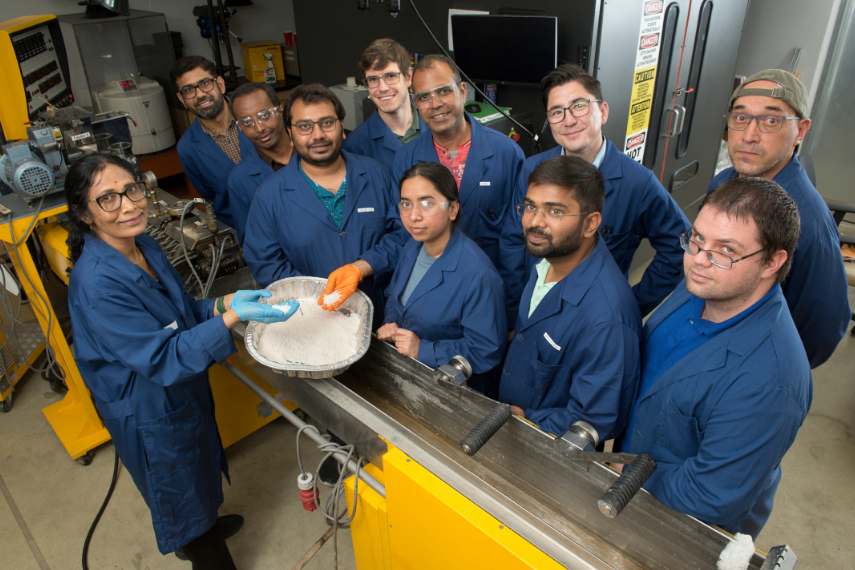Capturing Carbon with Sawdust

The Climate Crisis
Climate change is a serious threat to us and the planet, with our continued dependence on fossil fuels driving global warming to unprecedented levels. Carbon dioxide (CO2) is a major contributor to global warming, and is produced in the processing of fossil fuels. To reduce CO2 emissions and the impact on the environment, carbon capture technologies are being explored.
Activated carbon is a low cost material with many properties that make it desirable for carbon capture. However, most commercially used activated carbon is produced from non-renewable sources. Researchers in the University of Guelph’s School of Engineering are investigating the potential of more sustainable activated carbon sources in carbon capture technologies. They found a promising candidate in an abundant and economical source you can find in your own backyard – pine sawdust.

School of Engineering
A Renewable Alternative
Dr. Manjusri Misra, a Professor in the School of Engineering, wants to develop cost effective and sustainable solutions to carbon capture. To this end, her team (Drs. Himansu Patel, Haftom Weldekidan) along with Professor Amar Mohanty tested the carbon capture capabilities of activated carbon derived from pine sawdust. The sawdust was activated using different treatments in order to compare and optimize performance. Several properties were tested, including the CO2 adsorption capacity (a measure of the amount of CO2 that can be captured by a material) and the CO2 selectivity (the preference for capturing CO2 as opposed to other gases).
The different treatments were found to have an impact on the properties of the pine sawdust activated carbon. By optimizing the performance of the activated carbon though different treatments, the team produced an activated carbon that had an adsorption capacity well above the threshold for practical commercial use, and another treatment resulted in a material with a preference for adsorbing CO2 ~20x greater than nitrogen, the most abundant gas in our atmosphere. These results demonstrate that activated carbon from pine sawdust compares favourably with current commercially used activated carbon in carbon capture applications.
Benefits to the Environment
Innovative materials, such as activated carbon from pine sawdust, offer many potential benefits to the environment, beyond its carbon capture capabilities. “Upcycling of solid waste into activated carbon offers multifaceted environmental benefits, including a reduction of solid waste in landfills,” explains Misra. The unique pore structure of the pine sawdust activated carbon also opens up the possibility of trapping environmental pollutants other than CO2, such as pesticides, heavy metals, and dyes.
The team plans to continue studying the performance of activated carbon from pine sawdust in real-world applications involving exhaust from processing plants, called flue gas. “Future research studies will focus on pilot-scale testing of activated carbons from agricultural residues and food waste for real-life scenarios of flue gas emanating from power plants, cement plants, steel industries, petroleum refineries and other carbon intensive industries,” says Misra.

School of Engineering

Distinguished Research Chair in Sustainable Biomaterials at OAC.

This story was written by Carley Miki as part of the Science Communicators: Research @ CEPS initiative. Miki is a PhD candidate in the Department of Physics under Dr. John Dutcher. Her research focus is on understanding the forces and interactions between soft, sugar-based nanoparticles and how they differ when charged.
This work is supported by the National Sciences and Engineering Research Council (NSERC) of Canada, Canada Foundation for Innovation (CFI), the National Research Council (NRC), the Canadian Institutes of Health Research (CIHR), the Government of Saskatchewan, and the University of Saskatchewan.
Patel, H., Weldekidan, H., Mohanty, A., Misra, M. Effect of physicochemical activation on CO2 adsorption of activated porous carbon derived from pine sawdust. Carbon Capture Sci. Technol. 2023, 8, 100128. Doi: https://doi.org/10.1016/j.ccst.2023.100128
Additional studies by Misra’s research team: https://www.sciencedirect.com/science/article/pii/S2772656823000532